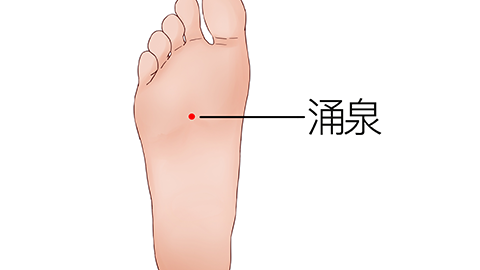Where is the Yongquan acupoint located, and what are its functions?
Under normal circumstances, the Yongquan point (KI1) is located on the sole of the human foot. The Yongquan point has functions including nourishing yin and benefiting the kidneys, refreshing the mind, regulating the endocrine system, promoting blood circulation, and relieving headaches. A detailed explanation is as follows:

I. Location
The Yongquan point is located on the sole of the foot, specifically at the center of the depression formed when the foot is flexed and the toes are curled. This location approximately corresponds to the intersection point located at the anterior one-third and posterior two-thirds of the line connecting the heel to the webbing between the second and third toes. The Yongquan point is the lowest acupoint in the human body, thus it is prone to invasion by cold and damp pathogenic factors. However, it also serves as an important hub for regulating the body's overall qi and blood circulation and maintaining yin-yang balance.
II. Functions
1. Nourishing Yin and Benefiting the Kidneys
The Yongquan point is the Jing-Well point of the Kidney Meridian of Foot-Shaoyin, and possesses the function of nourishing yin and benefiting the kidneys. Stimulating this point can nourish the kidneys and enhance kidney function, thereby alleviating symptoms such as soreness and weakness in the lower back and knees, dizziness, and blurred vision caused by kidney deficiency.
2. Refreshing the Mind and Opening the Orifices
The Yongquan point has the effect of opening the orifices and refreshing the mind and is clinically used for treating acute conditions such as coma, shock, and epilepsy. Stimulating the Yongquan point can promote blood circulation in the brain and achieve the effect of awakening consciousness.
3. Regulating the Endocrine System
The Yongquan point can regulate the endocrine system and has a certain relieving effect on gynecological symptoms such as irregular menstruation and dysmenorrhea. It can also promote digestion and alleviate symptoms such as stomach pain and indigestion.
4. Promoting Blood Circulation
Massaging or stimulating the Yongquan point can improve blood circulation in the feet, relieve symptoms such as cold hands and feet and varicose veins, and also accelerate the elimination of toxins in the body and promote metabolism.
5. Relieving Headaches
The Yongquan point also has a certain effect in relieving headaches, especially those caused by common colds or hypertension. Stimulating the Yongquan point can harmonize qi and blood and alleviate headache symptoms.
In daily life, it is important to maintain a regular schedule and ensure sufficient sleep to support the body's recovery and repair. Additionally, moderate exercise such as walking, jogging, and yoga should be practiced to promote overall blood circulation and maintain good health.







